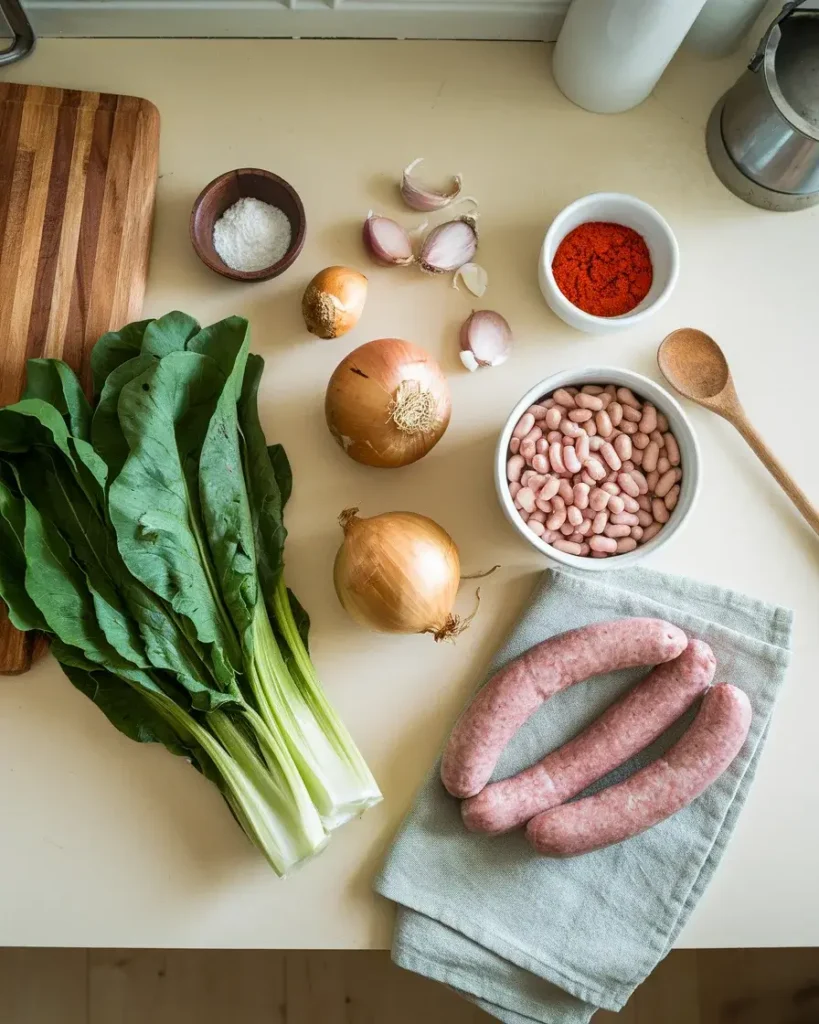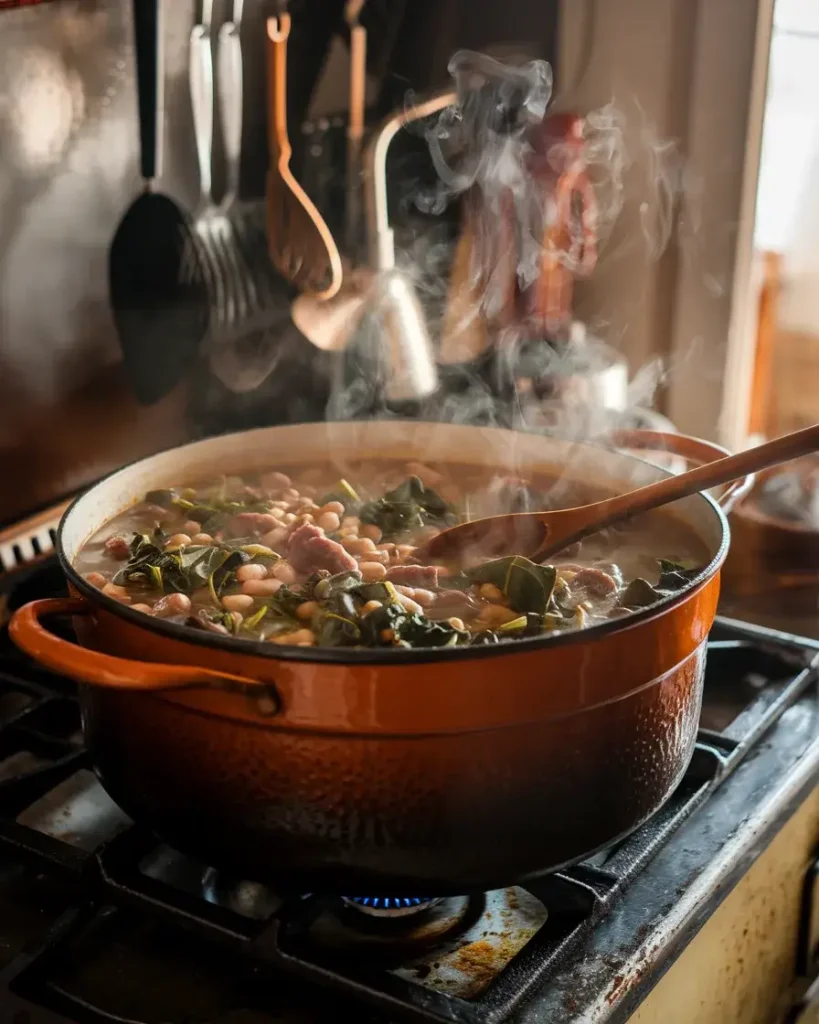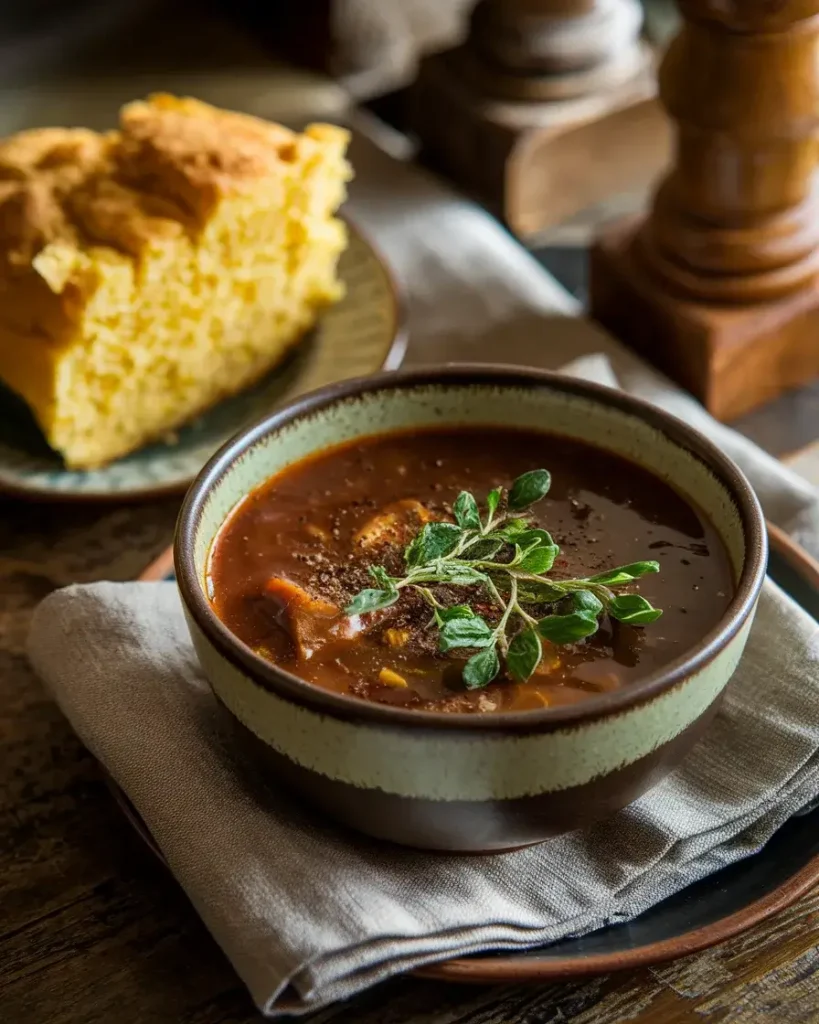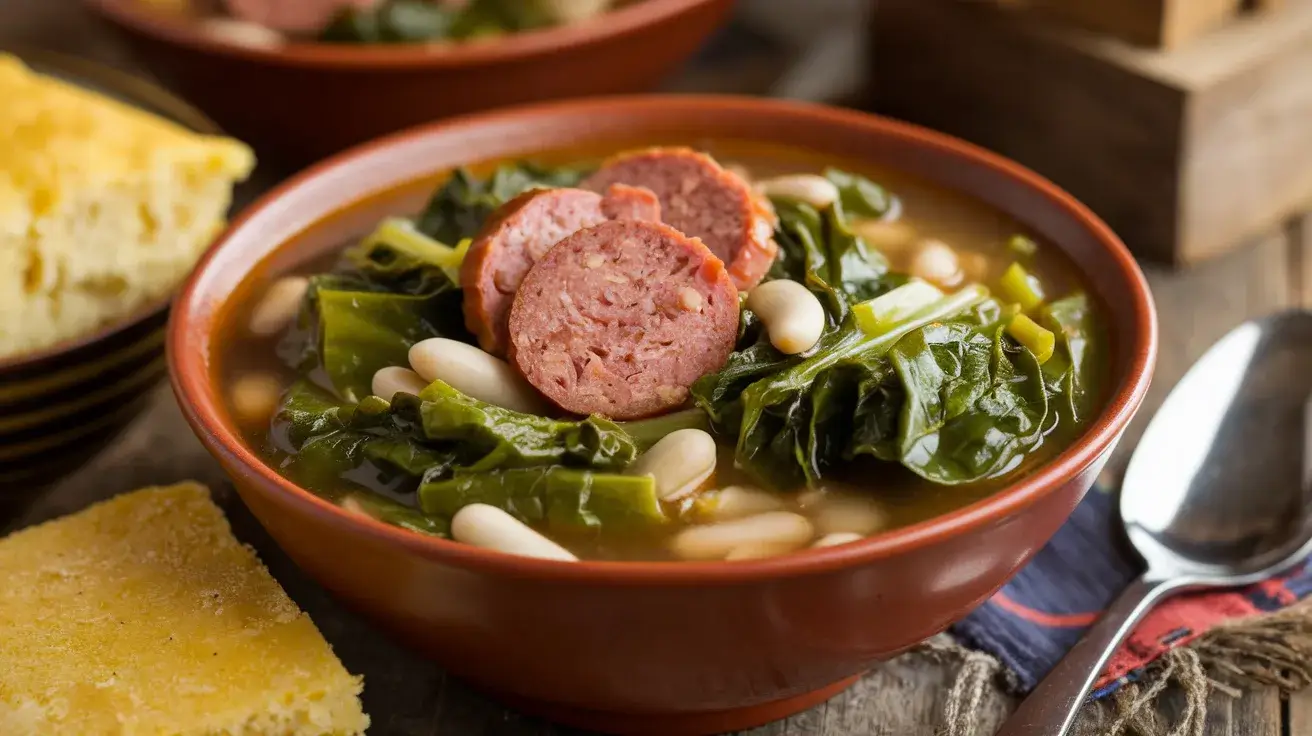Swamp soup is more than just a recipe—it’s a comforting embrace of earthy greens, rich broth, and simple ingredients that come together to warm both the body and soul. In fact, this guide will cover everything from the history of swamp soup recipes to variations, nutritional perks, and tips to serve this Southern favorite with style. Moreover, whether you’re a kitchen novice or a seasoned home chef, you’ll find this article helpful. Not only that, but it will also guide you in perfecting your swamp soup recipe while making it uniquely your own. By the end, you’ll feel confident crafting this dish for any occasion.
Let’s dive into the first section to understand what makes this dish a staple in Southern kitchens.
Introduction to Swamp Soup
What is Swamp Soup?
Swamp soup is a hearty, southern-inspired dish made with leafy greens like turnip greens, collards, or kale, paired with savory broth and aromatic seasonings. The name “swamp soup” comes from its characteristic green hue, resembling a vibrant swamp—but don’t let the name fool you. This dish is packed with delicious flavor and nutritional goodness! The soup is traditionally enjoyed in the southern United States, where it has become a symbol of comfort and community.
Origins of the Name ‘Swamp Soup’
The term “swamp soup” may sound playful, but it reflects the rustic charm of the dish. Historically, the soup was made with whatever greens were on hand, often grown in backyard gardens. The mix of greens and broth gave the dish its swampy appearance, while its rich flavor earned it a place on dinner tables far and wide.
Why This Recipe is Loved Across the South
From family gatherings to chilly evenings, swamp soup is a go-to dish for Southerners. Its simplicity, adaptability, and wholesome ingredients make it a crowd-pleaser. Plus, it’s a one-pot meal that’s easy to prepare, economical, and perfect for sharing. Southerners love their greens, and this soup brings out the best of what nature offers, turning humble ingredients into a bowl of comfort.
Key Ingredients for the Perfect Swamp Soup

Essential Ingredients for Authentic Swamp Soup
At the heart of any good swamp soup recipe lies its fresh and simple ingredients. The key component? Leafy greens. Turnip greens are a classic choice, but collard greens, kale, or mustard greens work just as well. These greens bring a natural earthiness and vibrant green color to the dish. Next up, a flavorful broth forms the base—chicken, vegetable, or even a smoked ham hock-infused stock can elevate the taste.
Aromatic vegetables like onions, garlic, and celery add depth, while beans (white beans or black-eyed peas) provide creaminess and protein. Don’t forget the smoked sausage or bacon for that quintessential Southern flair. And, of course, spices like black pepper, paprika, and a pinch of cayenne round out the flavors.
Optional Additions to Customize Your Soup
While the traditional recipe is timeless, there’s plenty of room for creativity. Add diced tomatoes for a touch of acidity or mix in sweet potatoes for a hint of sweetness. Love extra protein? Shredded chicken or ground turkey fits perfectly. Prefer a creamier texture? Stir in a splash of cream or coconut milk before serving.
Substitutions for Common Allergens
For those with dietary restrictions, it’s easy to make swaps without losing the dish’s character. Replace sausage with plant-based alternatives for a vegetarian version. Swap regular stock with gluten-free broth if needed. Even for dairy-free folks, the recipe can easily stay rich and satisfying with non-dairy creamers.
Step-by-Step Guide to Cooking Swamp Soup

Preparation: Organizing Ingredients and Equipment
Before you start cooking, gather all your ingredients and tools. A large pot is essential for cooking the soup evenly. Wash and chop your greens thoroughly, and dice your aromatics to keep the cooking process smooth. Preparing ahead will save time and make everything easier.
Cooking the Broth: Building the Flavor Base
To begin, heat some olive oil in the pot over medium heat. Add diced onions, garlic, and celery, cooking until they soften and release their aroma. Next, stir in the spices—paprika, black pepper, and cayenne—for a fragrant start. Pour in your broth and bring it to a simmer, letting the flavors blend beautifully.
Adding Greens: The Heart of the Recipe
Once the broth is simmering, it’s time for the greens to shine. Slowly add the washed greens into the pot, stirring gently to wilt them down. Their natural juices mix with the broth, creating the signature taste of swamp soup recipes. If you’re including beans or meat, now is the time to add them.
Final Touches: Seasoning and Adjustments
Taste and adjust the seasoning, adding salt or additional spices as needed. Let the soup simmer gently for 20–30 minutes, allowing all the ingredients to meld. Right before serving, you can add cream or a squeeze of lemon juice for a fresh finish.
Variations of Swamp Soup Recipes

Vegetarian and Vegan Swamp Soup Options
A traditional swamp soup recipe often includes meat, but you can easily make a plant-based version that’s just as hearty. Replace the sausage with plant-based alternatives or add more beans, like white beans or lentils, for a protein boost. Instead of chicken broth, opt for a rich vegetable stock infused with bay leaves and herbs. Coconut milk can also be stirred in for added creaminess without dairy.
Low-Carb and Keto-Friendly Versions
For those following a low-carb or keto lifestyle, swamp soup can be adapted to fit your dietary needs. Skip the beans and use smoked meats like sausage or ham to maintain that robust flavor. Adding diced zucchini or cauliflower rice can enhance the texture while keeping carbs low. A splash of heavy cream can add a rich finish.
Classic vs. Modern Interpretations
While the classic version of swamp soup sticks to leafy greens, beans, and smoked meats, modern twists allow for more creativity. You can experiment with spices like turmeric or garam masala for a global flair. Alternatively, tossing in a handful of quinoa or farro can transform the soup into a filling meal for adventurous eaters.
Nutritional Benefits of Swamp Soup
Health Advantages of Leafy Greens in Swamp Soup
Leafy greens like turnip greens, kale, and collards are nutritional powerhouses. They’re rich in vitamins A, C, and K, along with essential minerals like calcium and magnesium. These greens also provide a high dose of antioxidants, which support immune health and combat inflammation.
Protein and Fiber Content Breakdown
Thanks to its mix of greens, beans, and sometimes meats, swamp soup recipes offer a balanced combination of protein and fiber. Protein keeps you full longer, while fiber aids digestion and promotes gut health. Beans, in particular, are excellent for maintaining stable energy levels.
Low-Calorie Comfort Food
Despite its rich and satisfying taste, swamp soup is surprisingly low in calories. It’s a great option for those looking for a comforting meal without feeling weighed down. By using lean proteins or skipping meat altogether, you can enjoy this dish guilt-free.
For more hearty and comforting recipes, consider checking out Grandma’s Chicken Soup for another family-favorite soup idea.
Serving Suggestions and Pairings
What to Serve with Swamp Soup
A steaming bowl of swamp soup recipe deserves the perfect accompaniments to round out the meal. Freshly baked cornbread or crusty bread is a classic choice, ideal for soaking up every last drop of the flavorful broth. If you’re looking for a lighter side, a crisp green salad dressed with a tangy vinaigrette provides a refreshing contrast to the hearty soup.
For a Southern-inspired spread, serve your soup alongside deviled eggs or a platter of pickled vegetables. These small bites add both variety and a pop of flavor to the meal.
Seasonal and Occasion-Based Pairings
During colder months, pair your swamp soup recipe with hot apple cider or mulled wine for a cozy dining experience. In warmer weather, a glass of sweet iced tea can keep things light and refreshing. No matter the season, this dish is versatile enough to shine.
FAQs About Swamp Soup
What Are the Best Greens for Swamp Soup?
The beauty of a swamp soup recipe lies in its flexibility. Turnip greens are a traditional favorite, but kale, collards, and mustard greens are just as tasty. You can even mix different greens to create your own signature flavor.
Can Swamp Soup Be Made Ahead of Time?
Absolutely! Swamp soup is a perfect make-ahead meal. In fact, letting it sit for a day can deepen its flavors as the ingredients meld. Store it in an airtight container in the fridge and reheat it gently on the stove when ready to serve.
How Do You Store and Reheat Leftovers?
Leftover soup keeps well for up to three days in the fridge. For longer storage, freeze portions in individual containers for easy reheating. When warming up, add a splash of broth or water to maintain the right consistency.
Swamp Soup Recipe: Step-by-Step Instructions
Detailed Recipe with Measurements
Here’s a foolproof swamp soup recipe to bring this Southern classic to life.
Ingredients:
- 4 cups of turnip greens (washed and chopped)
- 1 medium onion (diced)
- 2 cloves of garlic (minced)
- 1 stalk of celery (chopped)
- 2 tablespoons of olive oil
- 6 cups of chicken or vegetable broth
- 1 can (15 oz) of white beans (rinsed and drained)
- 1 smoked sausage (sliced)
- 1 teaspoon of paprika
- 1/2 teaspoon of cayenne pepper
- Salt and black pepper to taste
- Optional: 1/2 cup of heavy cream or coconut milk for a creamy version
Instructions:
- Start with the Base: Heat olive oil in a large pot over medium heat. Add diced onion, garlic, and celery, sautéing until soft and fragrant.
- Build the Broth: Stir in paprika and cayenne pepper, then pour in the broth. Bring the mixture to a simmer.
- Add Greens and Protein: Add chopped turnip greens, stirring them into the broth until wilted. Toss in the smoked sausage and beans. Let everything cook together for 20–30 minutes, stirring occasionally.
- Season and Finish: Taste and adjust seasoning with salt and black pepper. For a creamy texture, stir in heavy cream or coconut milk just before serving.
Cooking Tips for Beginners
If you’re new to cooking soups, don’t worry—this recipe is forgiving. Start with fresh, pre-washed greens to save time, and use pre-cooked sausage to simplify the process. Remember, the soup gets better as it simmers, so be patient and let the flavors develop.
Common Mistakes to Avoid
Avoid over-salting the broth early on; the smoked sausage adds saltiness as it cooks. Also, don’t rush the simmering step—this is where the magic happens, allowing the flavors to meld beautifully.

